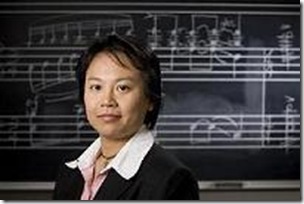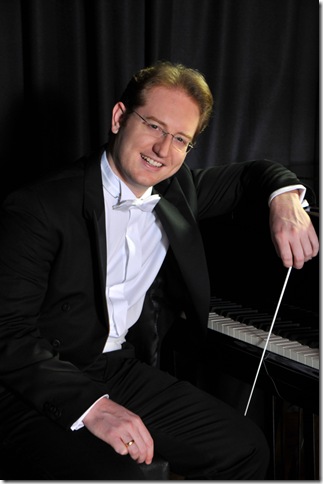Lynn Philharmonia/Gunther Schuller (Jan. 29, Wold Performing Arts Center, Boca Raton)
“I am Chiayu!” the small woman wearing a red dress jacket almost shouted to the audience at the Wold Performing Arts Center as she took the stage at Lynn University in Boca Raton to introduce her new composition.
Chiayu Hsu, a Taiwan-born composer who earned her doctorate at Duke University, was the winner of the call for scores offered by the fifth New Music Festival at Lynn. Her short orchestral work, Shan Ko (Mountain Song), is the middle section of a trilogy that evokes the natural world of her native island off the coast of China.
The Lynn Philharmonia, under guest conductor Gunther Schuller, gave the first public performance of the work at the Jan. 29 concert (it had a reading by the Nashville Symphony last year), and it showed us a composer well-versed in the late Romantic tradition even if the language was considerably more modern. As a descriptive piece about a walk in the mountains, buttressed with a regional folksong to add color and building material, it had the kind of atmospheric writing you would expect.
It evoked Richard Strauss’ Ein Alpensinfonie and the Mahler Sixth Symphony, especially in the waves of glistening celesta in the middle, and in its general structure overall. It has clear, strong motifs that rise out of mysterious percussion in the beginning, and then break out in colorfully orchestrated sections amid very evocative sound-painting that makes wide and canny use of instrumental potentialities. Most of it is quite tonal, and its vivid scoring and muscular structure help it make a strong, almost epic impression.
It’s not particularly original, but it is well-crafted and effective, and it has an attractive bigness that is well-suited for its purpose as a piece of descriptive nature music.
The premiere was followed by a performance of the Piano Concerto No. 1 (in C minor, Op. 35) of Dmitri Shostakovich, with New Music Festival founder Lisa Leonard as the piano soloist and her husband, Lynn brass chairman Marc Reese, as the trumpet soloist.
Leonard demonstrated again with this strong, technically immaculate performance why she is one of the area’s most rewarding pianists to listen to. She brings to this music equal parts steel, flash, and poetry, and you can hear clearly that she has thought about how she wants to interpret every bar. It is satisfying music-making in the best sense, and from the slowly unfolding, gradually warming-up way that she played the first notes she had the audience lured in for the duration.
Reese also played quite well, with a forceful, powerful sound that fulfilled the composer’s use of it as a foil to the piano and to the string orchestra behind it. The Lynn Philharmonia strings had intonation difficulties in the early going, but by the finale were much more on point, and the conclusion of the concerto was suitably athletic and joyous.
The concert, which opened with a very shaky, out-of-tune reading of the Representation of Chaos prelude from Haydn’s The Creation, closed with a relatively decent version of the Third Symphony (in F, Op. 90) of Brahms.
Schuller led the Brahms in a no-nonsense manner of rather swift tempi and very little rubato, so that the contrasting wind theme in the first movement simply moved forward (with good attention to dynamics), and the traditional hesitations at its end, leading into a flexible, warm reply from the strings, were not there. And the second theme of the finale, where many conductors take advantage of the quarter-note triplets to broaden the tempo a little bit, also charged ahead in steady, unsentimental fashion.
Here, too, intonation was an issue in the first two movements, with some weak brass playing in the slow movement especially. But the cello theme of the third movement was a different story, and the solo horn played this theme ably when the time came, with accuracy if not notably beautiful sound. – G. Stepanich
Palm Beach Symphony (Jan. 24, Bethesda-by-the-Sea Episcopal Church, Boca Raton)
“It isn’t fair,” said the sweet elderly lady next to me. “I’m from Cleveland, and the Cleveland [Orchestra] begins on time.”
The Jan. 24 concert by the Palm Beach Symphony at Bethesda-by-the Sea Episcopal Church got under way at 7:25 p.m., some 25 minutes after it was supposed to start. With 80 percent of the audience present, late diners from a dinner organized by the symphony strolled in, perhaps unaware they’d kept everybody waiting.
Once the music began, it opened with Beethoven’s Coriolan Overture (Op. 62), written for a friend’s play of the same name. Smooth string playing, especially in the throbbing surge at the start, said that conductor Ramon Tebar meant business. As a concert warmer, though, it was wholly out of place with the rest of the program of two Ravel pieces and a light Schubert symphony.
In this church chancel setting, the full orchestra sounded muddy, and the brass section almost vulgar. It’s a very Germanic composition, and something by Debussy would have been a better choice in view of what was to follow.
After considerable chair shifting, nicely handled by two caring gentlemen, Ravel’s Introduction and Allegro for harp, string quartet, flute and clarinet set the tone for the rest of the evening. Kay Kemper sat front and center with her harp and played beautifully; the other six players behind her, no conductor. It was a magnificent 10 minutes of lush and magical music-making, with glissandos and crescendos tumbling from the harp and the sextet providing gorgeous moments of rapturous Impressionistic sounds.
A second Ravel piece, the four-movement Le Tombeau de Couperin, followed. What a contrast to Beethoven’s writing. In the fugal section, the brass sounded infinitely more gentle than they had done in the harshness of the Coriolan. The woodwinds sounded wonderful, almost piano-like on occasion: Ravel’s nod to Couperin’s keyboard skill, no doubt. The fast-paced Rigaudon, the last movement, was taken at breakneck speed, and the orchestra kept pace for a thrilling performance.
The second half of the program was given over to the Symphony No. 6 (in C, D. 589) of Schubert. Written when the composer was 21, the symphony is scored for an orchestra of the size of the Palm Beach Symphony. The work evokes the “Rossini craze” of the early 19th century, with much Italianate writing in the woodwind ornamental figures.
Yet it also is unmistakably the work of the master of the Lied. Tebar coaxed some lovely playing from the orchestra in the tuneful first movement, and the second-movement Andante was like a minuet, quiet and stately with beautiful woodwind chords ending in pure serenity.
The lively Scherzo with its familiar-sounding tunes plugged along with reminders of Beethoven and his brassy chords (Coriolan again!). The finale had many graceful melodies unfolding one after another, all of which were tightly played by a very talented group of professional instrumentalists. – Rex Hearn

